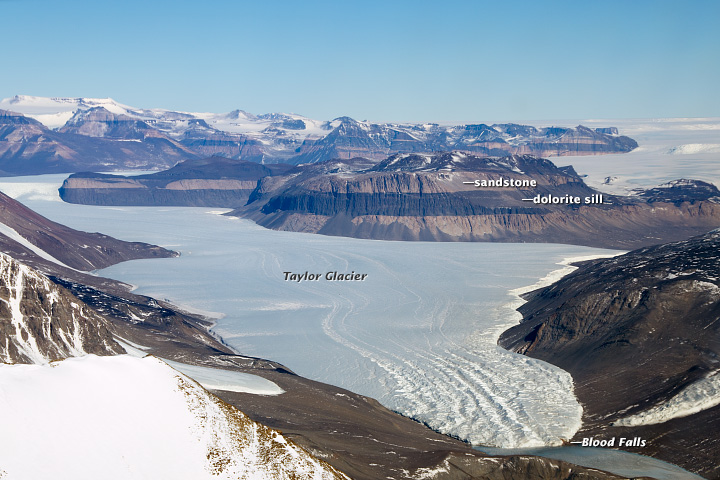NASA: Antartica - Antartida - Taylor Valley - 12.13.13
Posted by Ricardo Marcenaro | Posted in NASA: Antartica - Antartida - Taylor Valley - 12.13.13 | Posted on 13:49

acquired November 19, 2013
download large image (2 MB, JPEG, 4302x2868)
While flying over Antarctica aboard a P-3 aircraft in November 2013, Operation IceBridge project scientist Michael Studinger took this photograph (top) of Taylor Valley, one of Antarctica’s unique dry valleys.
Home to Taylor Glacier, striking rock outcrops, and Blood Falls, the
valley is one of the most remote and geologically exotic places in the
world. A satellite image (bottom) captured by the Operational Land Imager (OLI) on Landsat 8 shows a portion of the same area from above.
While ice and snow covers most of Antarctica, Taylor Valley
and the other dry valleys are conspicuously bare. Inland mountains—the
Transantarctic Range—force moisture out of the air as it passes over,
leaving the valley in a precipitation shadow.
The lack of precipitation leaves dramatic sequences of exposed rock. In
both the satellite image and photograph, the tan bands are sandstone
layers from the Beacon Supergroup,
a series of sedimentary rock layers formed at the bottom of a shallow
sea between 250 million and 400 million years ago. Throughout that
period, Earth’s southern continents were locked into the supercontinent Gondwana.
The dark band of rock that divides the sandstone is dolerite
(sometimes called diabase), a volcanic rock that forms underground. The
distinctive dolerite intrusion—or sill—is a remnant of a massive
volcanic plumbing system that produced major eruptions about 180 million
years ago. The eruptions likely helped tear Gondwana apart.
The dominant feature in the photograph—Taylor Glacier—is notable as
well. Like other glaciers in the Dry Valleys, it is “cold-based,”
meaning its bottom is frozen to the ground below. The rest of the
world’s glaciers are “wet-based,” meaning they scrape over the bedrock,
picking up and leaving obvious piles of debris (moraines) along their edges.
Cold-based glaciers flow more like putty, pushed forward by their own
weight. Cold-based glaciers pick up minimal debris, cause little
erosion, and leave only small moraines. They even look different from
above. Instead of having surfaces full of crevasses, cold-based glaciers are comparatively flat and smooth.
At the lower right of the photograph, “Blood Falls”
appears as a small, dark smudge. The name refers to the stain of red
that coats part of the glacier and seeps down toward Lake Bonney in a
pattern that makes it look like a blood-red waterfall. The red comes
from microbes
living within a pool of ancient seawater that has been trapped beneath
Taylor Glacier for at least 1.5 million years. Due to the activity of
the microbes, the seawater is enriched with ferrous hydroxide (an
iron-containing salt), which quickly oxidizes and turns red as it seeps
out of a crack in the glacier.
-
Further Reading
- Bradshaw, M. (2013, August 6) The Taylor Group (Beacon Supergroup): the Devonian sediments of Antarctica. Geological Society (81), 67-97. Accessed December 6, 2013.
- Goddard Earth Science Data and Information Services Center Dry Valleys, Antarctica. Accessed December 6, 2013.
- NASA IceBridge - Antarctic 2013. Accessed December 3, 2013.
- Natural History Magazine (2005, July) Cold Fire. Accessed December 6, 20132.
- Taylor Valley (2012, October 22) Taylor Valley Antarctica. Accessed December 20, 2012.
NASA Earth Observatory images by Robert Simmon, using Landsat 8 data from the USGS Earth Explorer. Caption by Adam Voiland.
- Instrument:
- Landsat 8 - OLI
NASA: Antartica - Antartida - Taylor Valley - 12.13.13
Ricardo M Marcenaro - Facebook
Blogs in operation of The Solitary Dog:
Solitary Dog Sculptor: byricardomarcenaro.blogspot.com
Solitary Dog Sculptor I: byricardomarcenaroi.blogspot.com/
Para:
comunicarse conmigo,
enviar materiales para publicar,
propuestas comerciales:
comunicarse conmigo,
enviar materiales para publicar,
propuestas comerciales:
marcenaroescultor@gmail.com
For:
contact me,
submit materials for publication,
commercial proposals:
For:
contact me,
submit materials for publication,
commercial proposals:
marcenaroescultor@gmail.com
My blogs are an open house to all cultures, religions and countries. Be a follower if you like it, with this action you are building a new culture of tolerance, open mind and heart for peace, love and human respect. Thanks :)
Mis blogs son una casa abierta a todas las culturas, religiones y países. Se un seguidor si quieres, con esta acción usted está construyendo una nueva cultura de la tolerancia, la mente y el corazón abiertos para la paz, el amor y el respeto humano. Gracias:)
(::)



Bellisimo paisaje, no hubiera imaginado algo así en la Antártida... pero lo que más me llamó la atención es la llamada Blood Falls, en resonancia con la obra de Kapoor que acabo de postear...
Hola Anabela, gracias por tu comentario, voy a ver si encuentro el post, me encantaría ir a Antártida
Besos